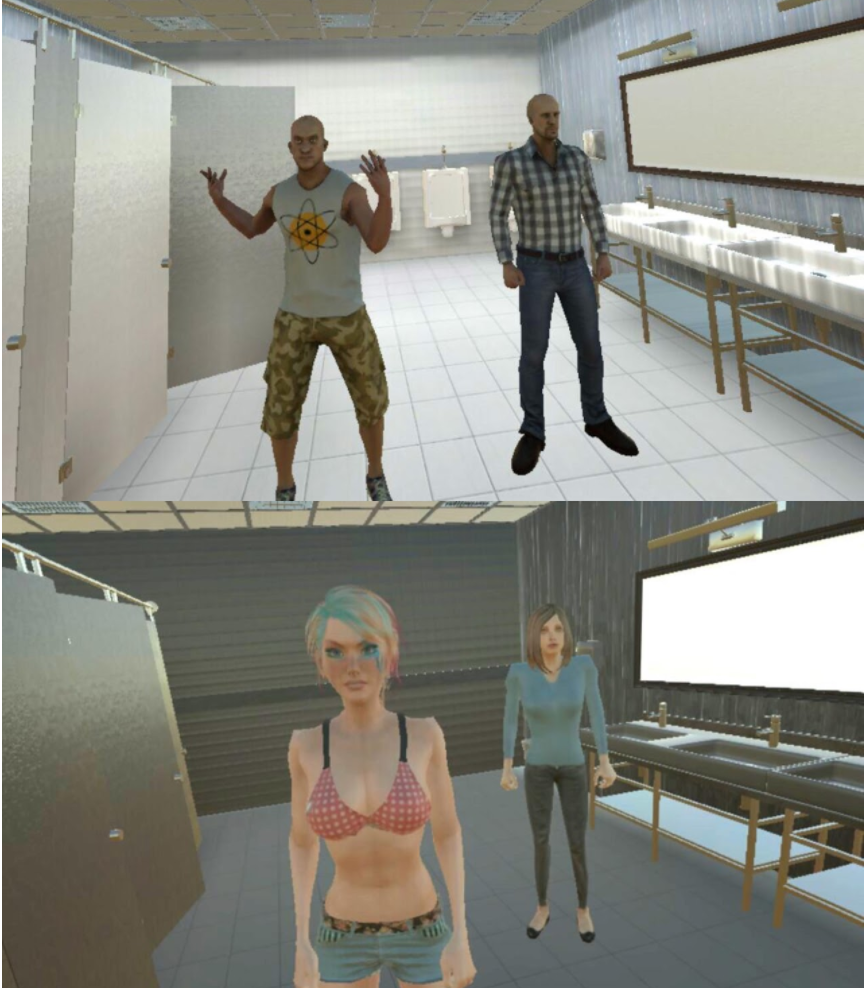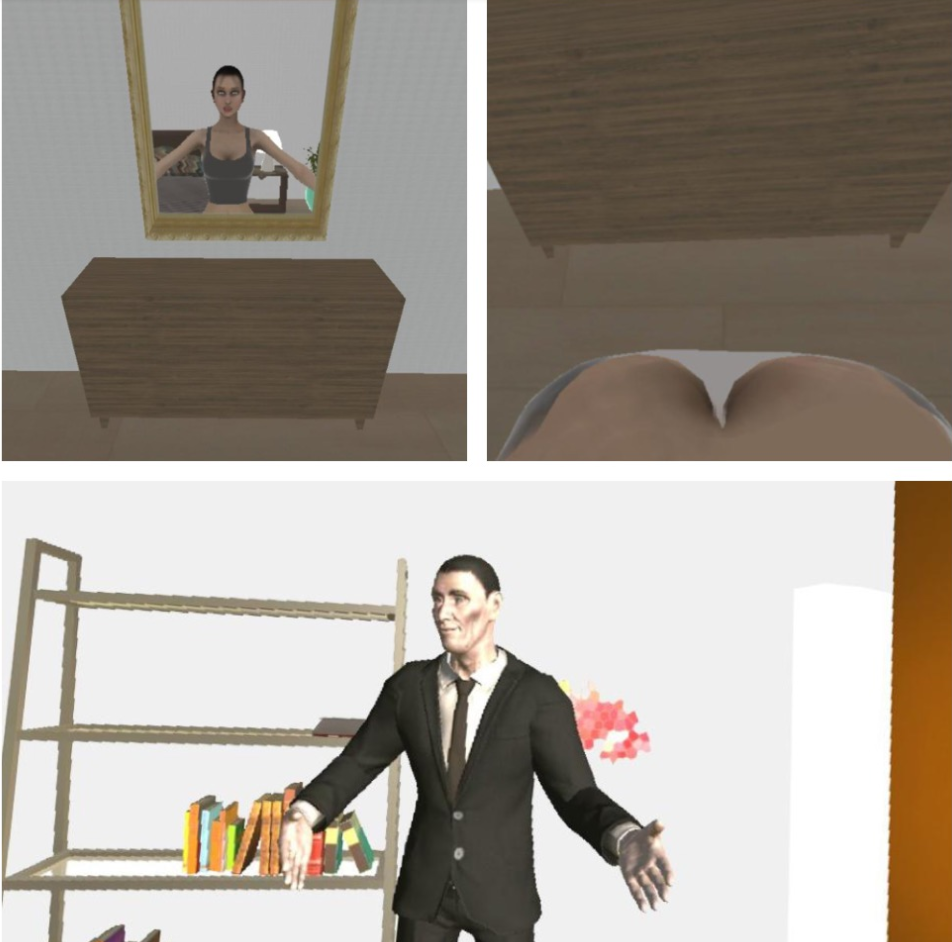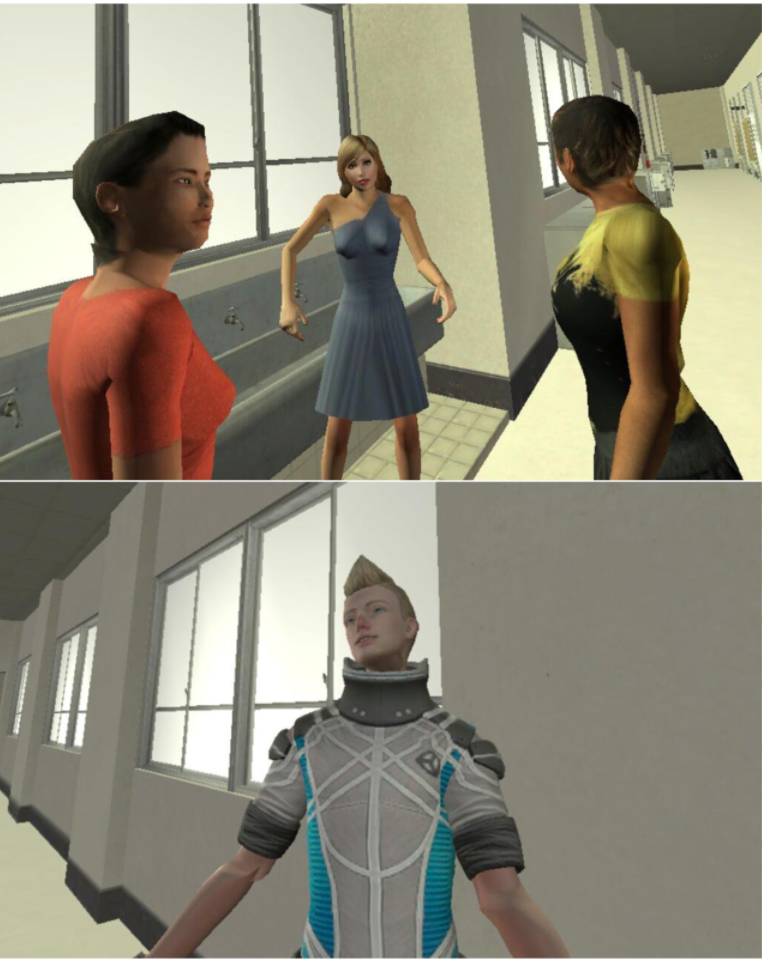Overview
Idea / Vision
In TRANS-formation, we used virtual reality embodiment technology to evoke empathy by immersing a CIS-gender player in a transgender body and presenting them with the daily life struggles from a transgender’s perspective. We intend to use this game to reduce CIS-gender’s biases towards the transgender community.
Motivation
According to recent statistics, the LGBTQ community worldwide still faces considerable stigma. Study reports that the LGBTQ students are at higher risk for being bullied, with the transgender students being the most vulnerable subgroup and suffering from the most violent cases of physical attacks. Transphobia is still well and alive. In 2014, at least 13 transgender woman were being violently murdered by their intimate partners and strangers (Human Rights Campaign).
The 2014 State Equality Index indicates that currently in the United States, only 18 states and D.C. formally forbids employment and housing discriminations based on gender identity (Human Rights Campaign). Recently, the Trump administration has removed Obama-era protection that allows transgender students to use bathrooms and facilities according to their gender identities. The lack of legal protection has endangered the transgender population and motivated further attacks towards the community.1
Background Work
The concept of perspective-taking has been extensively studied as an intervention method for social prejudice and stereotyping in social psychology.2 3 4 Perspective-taking has been found to yield an increased overlap between self and the others and has produced positive interpersonal effects.5
With the emergence of the virtual reality (VR) technology, prior studies have explored the effects of embodied perspective-taking in immersive VR on reducing negative social stereotyping. Yee and Bailenson (2006) showed that people stereotyped the elderly less negatively when being placed in avatars of old people, compared to those who were placed in avatars of young people. In this study, the participants were embodied as an avatar in a VR environment. Their embodiment is enhanced by seeing their self-reflections via a virtual mirror.
The virtual reality technology (VR) has played a critical role in inducing illusions of body ownership and reducing human’s implicit bias and prejudice towards certain ‘outgroups’. For instance, inhabiting light-skinned people in a black virtual body avatar has proved to be effective in reducing bias towards dark-skinned people.6 The paper argued that illusions of body ownership induces an increase in perceived similarity between self and an outgroup and thus lead to a generalization of self-like associations to an outgroup.7 The identification with a virtual body in VR has also been used to cultivate compassion and maintain psychological well-being. One study uses an embodied first-person perspective in VR to let people become the recipient of their own behaviors, and thus cultivate self-compassion and reduce self-criticism.8
Despite extensive work in reducing racial bias and cultivating positive psychological attitudes via VR, little work has been targeted at reducing social prejudice and discrimination against the LGBTQ communities. There is one study that explores the effect of users’ gender on perception of the virtual body’s hands the users embody (Schwind et al., 2017). The study found out that women experienced less presence in VR when they embodied male hands. However, little study has been done to investigate how the mismatch between a user’s real gender and virtual gender has influenced his or her perception of the other gender. We still know little about how such mismatch has potentially influenced one’s gender bias.
Related Work
There are a few related projects that attempt to address gender and sexuality bias. First, ‘Girl Mirror Look’ is an Oculus Rift game that lets players walk around a mansion and look at their reflection in the mirror. The game introduces a rudimentary way for a male player to inhabit the body of a woman9.
‘The Circle’ is a first-person and third-person Oculus touch game that is played through the eyes of a wheelchaired transgender woman, Alex. Suffering from PTSD and recovering from a devastated transphobic attack, Alex becomes obsessed with a conspiracy theory in her apartment. As the story blurs between reality and fantasy, the player was put into the life of a relatable character. The game draws inspiration from real life data on transphobic violence and intends to address issues of gender and identity.10 This game, however, does not create any illusions of body ownership for players because the players cannot see any parts of the avatar.
‘Be Another Lab’ is a Spanish design collective that focuses on projects between identity and empathy with the help of virtual reality technologies. The Machine to be Another, is an embodied narrative virtual reality system that allows people to experience the world from another’s body. ‘Gender Swap’ is one of the experiments that let people from opposite sexes to swap bodies and seeing other’s body part with the illusion of feeling their touch. The project is done with the purpose of helping scientists explore and quantify concepts such as sexism and gender identity through body transference9.
Among these studies, we notice that none of them actually let users directly embody a transgender avatar and experience the daily social discriminations transgenders face.
Design and Implementation
We used Gear VR as our development platform to design and implement an immersive role-playing game in which the player embodies a transgender boy avatar. The game is programed and created using the Unity engine, as shown in Figure 1. In the game, the user is able to rotate his head and controls his/her movement in virtual space.
The player of the game is able to observe part of his virtual body that has female features. For example, the player could look down and observe that his virtual body has female breasts. This embodiment design intends to create a sense of body ownership so that the player could be more immersively standing in the shoes of a transgender boy.
Since our project attempts to present daily challenges and difficulties that transgender teenagers face, we simulate social interaction based on real-life data. We interviewed a few transgenders and LGBTQ people, and learned about the hurtful moments they encounter in daily social interaction. In addition, we also consulted trans* ally guides from several well-known organizations such as LGBT and Trans* organizations (e.g., National Center for Transgender Equality, Gay & Lesbian Alliance Against Defamation). Based on the above resources, we categorized the daily social interaction into the following: explicit insults and humiliation, binary gender stereotyping and stigma, implicit prejudice and bias, and trans* allies. Table 1 below shows these different examples.
With the information above, we implemented our game in three different settings where most of the social interactions happen. The three settings are home, school and bathroom. Table 2 below displays a more detailed description of the scenarios.
In the home setting, the avatar first talks to a mirror about his gender and his wishes to live as a boy. Then, he encounters his father in the living room who still perceives him as a girl rather than a boy. This scenario is displayed in Figure 2.
In school, a player can choose where to go and who to interact with. For example, the player could choose which bathroom he wants to go to. However, no matter which bathroom he goes to, he would either be humiliated or embarrassment. This scenario is displayed in Figure 3.
The player could also choose to interact with his classmates, who are talking about a upcoming high school prom. This scenario is designed to make the players feel awkward about the gender binary activities (e.g., proms and scouts) because these activities often have enforced strict gender roles based on one’s biological sex. As a result, he faces considerable social pressure from his cis-gender classmates. The transgender boy that the player embodies has a friend, who the player could interact with. This friend, out of sympathy, offers him ‘kindly’ advice on being ‘transgender’. The suggestion he received turned out to be implicitly biased and prejudiced, as shown in Figure 4.
Usage Scenario
Our game is designed for three different scenarios. First, we want to release the application on unity asset store as a role-playing game targeted at CIS-gender population. We hope that by playing the game, the players will increase their social awareness of advocating civil rights for the transgender community.
Secondly, we are interested in introducing the game to transgender allies and families who have close relationship with the transgender population. We intend to help the allies better understand the community and support them in the coming-out and the transition process.
Thirdly, we envision the game as part of the high-school/middle-school sex education program for teachers and students. By immersing young children in the game, we hope to better communicate the concepts of cis-gender and transgender and to eliminate bullying and reduce discrimination.
Conclusion and Future Work
For future work, we are considering inviting cis-gender people to participate in the game. To measure the effectiveness of the application, we would like to ask the players to take gender attitude test before and after the game. We will also collect data from our rating system as part of our analysis.
We are planning on conducting more work in virtual reality body ownership. In the future, players could see other parts of their body throughout the entire game. We will add more visceral interactions such as asking the user to put on underwear for the avatar or wear gender-stereotyped clothing. We are looking to reduce the number of settings and intensify each setting’s social interaction. By inducing fear or disgust after a transphobic interaction, we want to enhance the sense of body ownership for the player. Lastly, we are thinking about implementing a male avatar so that cis-gender woman could experience the life of a transwoman.
Citations/Bibliography
-
De Vogue, Ariane, Mary Kay Mallonee, and Emanuella Grinberg. ‘Trump administration withdraws federal protections for transgender students.’ CNN. February 23, 2017. http://www.cnn.com/2017/02/22/politics/doj-withdraws-federal-protections-on-transgender-bathrooms-in-schools/. ↩
-
Galinsky, A.D. and G.B. Moskowitz, Perspective-taking: Decreasing stereotype expression, stereotype accessibility, and in-group favoritism. Journal of Personality and Social Psychology, 2000. 78: p. 708-724. ↩
-
Greenwald, A.G., D.E. McGhee, and J.K.L. Schwartz, Measuring individual differences in implicit cognition: Theimplicit association test. Journal of Personality and Social Psychology, 1998. 74: p. 1464-1480. ↩
-
Perdue, C.W. and M.B. Gurtman, Evidence for the automaticity of ageism. Journal of Experimental Social Psychology. Journal of Personality and Social Psychology, 1990. 26: p. 199-216. ↩
-
Davis, M.H., et al., Effect of perspective taking on the cognitive representation of persons: A merging of self and other. Journal of Personality and Social Psychology, 1996. 70: p. 713-726. ↩
-
Peck, T. C., Seinfeld, S., Aglioti, S. M., and Slater, M. (2013). Putting yourself in the skin of a black avatar reduces implicit racial bias. Conscious. Cogn. 22, 779–787. doi: 10.1016/j.concog.2013.04.016 ↩
-
Maister, L. ,M. Slater, M.V. Sanchez-Vives, M. Tsakiris, Changing bodies changes minds: owning another body affects social cognition Trends Cogn. Sci., 19 (2015), pp. 6–12 ↩
-
Falconer, C. J. et al. Embodying Compassion: A Virtual Reality Paradigm for Overcoming Excessive Self-Criticism. PLoS One 9, 10.1371/journal.pone.0111933 (2014). ↩
-
Kuchera, B. ‘Being someone else: How virtual reality is allowing men and women to swap bodies.’ Polygon. March 4, 2014. https://www.polygon.com/2014/3/4/5423330/oculus-rift-vr-gender-swap-girl-mirror-look. ↩ ↩2
-
Souppouris, A. ‘VR helped me grasp the life of a transgender wheelchair user.’ Engadget. October 17, 2016. https://www.engadget.com/2016/10/17/the-circle-vr-manos-agianniotakis-nfts-games/. ↩


